Ø Plumage / ˈpluːmɪdʒ / (ˈপ্লূমিজ্) n [the feathers covering a bird’s] (পাখির পালক; পুচ্ছ): Male peacocks have beautiful plumage.
Ø Down / daʊn
/ (ডাউন্) n [the
very fine soft feathers of a bird] (কোমল/
নরম পালক): goose/duck down
Ø Wing / wɪŋ / (উইং) n [one of the parts of the body of a bird, insect, or bat that it uses for flying] (ডানা; পাখা): The pigeon flapped its wings noisily
 |
| Spine |
Ø Spine / spaɪn / (স্পাইন্) n [the row of small bones that are connected together down the middle of the back] (মেরুদণ্ড): He injured his spine in a riding accident.
<SYN> Backbone
Ø Characterize / ˈkærəktəraɪz / (ˈক্যারএকটএরাইজ) v [to describe or show the qualities of Sb/Sth in a particular way] (চিহ্নিত করা): Activities that are characterized as ‘male’ or ‘female’ work.
 |
| Beak |
Ø Beak / biːk / (বীক্) n [the hard pointed or curved outer part of a bird’s mouth] (পাখির ঠোঁট; চঞ্চু): Birds use their beaks to pick up food.
<SYN> Bill
Ø Metabolism / məˈtæbəlɪzəm / (মএˈট্যাবএলিজম্) n [the chemical processes in living things that cause food to be used for energy and growth] (জীবদেহের রাসায়নিক রূপান্তর; বিপাক): The body’s metabolism is slowed down by extreme heat.
Metabolic / ˌmetəˈbɑːlɪk / (ˌমেটএˈবালিক) adj (বিপাকীয়): a metabolic process/disorder
Metabolize / məˈtæbəlaɪz / (মএˈঠ্যাবএলাইজ) v [to turn food, minerals, etc. in the body into new cells, energy and waste products by means of chemical processes] (বিপাক করা বা হওয়া; < জীব> বিপাকক্রিয়ায় খাদ্য শোষণ করে ব্যবহার করা): We metabolize alcohol at different rates.
 |
| Skeleton |
Ø Skeleton / ˈskelɪtn / (ˈস্কেলিটন্) n [the frame of bones that supports the body of a person or an animal] (প্রাণি দেহের কঙ্কাল): The bird has many fewer bones in their skeletons than a human body (who have 206).
Ø Squawk / skwɔːk / (স্কোয়াক্)
n [(of birds) to make an unpleasantly loud, sharp sound] (<পাখি সম্বন্ধে>কোঁ কোঁ শব্দ করা):
Oriental Magpie Robin
Oriental Magpie Robin / ˌɔːriˈentlˈ mægpaɪ ˈrɑːbɪn / (ˌওরিˈএনটল্ ˈম্যাগপাই ˈরা্বিন) n [this bird is about 19 centimeters long. It has black upper parts, head, and throat apart from a white shoulder patch. The underparts and the sides of the long tail are white. It is the national bird of Bangladesh] (দোয়েল): The Oriental Magpie Robin is found in open woodland, cultivated areas, and often close to human habitation. The food of Magpie Robin is mainly insects, grains, and other invertebrates.
Ø Oriental / ˌɔːriˈentl / (ˌওরিˈএন্টল্)
n [connected with or typical of the eastern part of the world, especially China
and Japan, and the people who live there] (প্রাচ্য/পূর্বদেশীয়):
 |
| Patch |
Ø Patch / pætʃ / (প্যাচ্) n [a small area of Sth, especially one which is different from the area around it] (কোনোকিছুর উপরিভাগে ভিন্ন রঙের অনিয়মিত ছোট কোনো অংশ; তালি; দাগ): Our dog has a black patch on his back.
<VERB> Patch [to cover a hole or a torn place, with a piece of cloth or other material] (তালি দেওয়া): a shirt with patched(=তালি দেওয়া শার্ট)
<SYN> Mend
Ø Woodland / ˈwʊdlənd / (ˈউডলএড্) n [an area of land that is covered with trees] (বনভূমি; অরণ্য): The house is fringed by woodland and fields.
Ø Habitation / ˌhæbɪˈteɪʃn / (ˌহ্যাবিˈটেইশন্) n [suitable for people to live in] (জনবসতি; বাসস্থান): I find the old quite habitable.
<ADJ> Habitable / ˈhæbɪtəbl / (ˈহ্যাবিটএব্ল্) adj [suitable for people to live in] (বাসযোগ্য): I find the old house quite habitable.
 |
| Insect |
Ø Insect / ˈɪnsekt / (ˈইনছেকট্) n [any very small animal with many legs, and a body divided into three parts and usually two pairs of wings, or more generally] (কীটপতেঙ্গ; পোকামাকড়): The pesticide is lethal to all insect life. Ants, beetles, and flies are all insects.
 |
| Grain |
Ø Grain / greɪn / (গ্রেইন্) n [the small hard seeds of food plants, especially a plant-like grass such as wheat, rice] (খাদ্যশস্য; শস্যকণা): Grain is one of the main exports of the Midwest.
Ø Invertebrate / ɪnˈvɜːrtɪbrət / (ইনˈভা্র্টিব্রএট) n [any animal with no backbone/spine, such as a worm] (অমেরুদণ্ডীপ্রাণী):
Magpie
Magpie / ˈmæɡpaɪ /
(ˈম্যাগপাই) n [a bird with
black and white feathers with a long tail and has a noisy cry] (ম্যাগপাই <পাখি>): Magpies are attracted to small, shiny objects, which they carry away
to their nests.
Robin
Robin / ˈrɑːbɪn /
(ˈরাঃরিন্) n 1. (North American Robin) [a brown bird found in North America. The male has a
reddish-brown breast. They are larger than European ones] (রাবিন):
2. Robin n
(European Robin) [a small brown bird found in Europe. The male has a red neck
and breast] (রাবিন):
Blackbird
Blackbird / ˈblækbɜːrd / (ˈব্ল্যাক্বাঃর্ড্) n [a European bird, the male of which has
black feathers and a bright yellow beak, and the female has brown feathers] (ইউরৌপিয়ান
কালো পাখি):
Baya Weaver
Baya Weaver / ˈbʌɪə ˈwiːvər / (ˈবাইএ ˈউঈভএর) n [the Baya Weaver is a bird found across the Indian subcontinent, Flocks of these birds are found in grasslands, cultivated areas, and they are best known for their hanging retort shaped nests woven from leaves. These nest colonies are usually found in thorny trees or palm fronds and the nests are often built near water or hanging over the water where predators cannot reach easily] (বাবুই): Baya Weavers are best known for the elaborately woven nests constructed by the males.
 |
| Flock |
Ø Flock / flɑːk / (ফ্লাঃক্) n [a group of sheep, goats or birds of the same type] (<পাখির>ঝাঁক; <পশুর>পাল): A flock of birds passed overhead.
<VERB> Flock / flɑːk / (ফ্লাঃক্) v {Pt. Pp. flocked / flɑːkt / (ফ্লাঃক্ট্)} [to move or gather together in large numbers] (ঝাঁকে ঝাঁকে জমায়েত হওয়া বা আসা): Huge numbers of birds had flocked together by the lake.
Ø Grassland / ˈgræslænd / (ˈগ্র্যাছল্যান্ড) n [a large area of open land covered with wild grass] (তৃণভূমি): turning grassland into farmland
Ø Retort / rɪˈtɔːrt / (রিˈটোর্ট) n [a closed bottle with a long, narrow bent spout that is used in a laboratory for heating chemicals] (গলাওয়ালা জগ): Retort is Laboratory equipment.
Ø Weave / wiːv / (উঈভ্) v {Pt. wove / woʊv / (ঔভ্); Pp. woven / woʊvn / (উঔভন্)} [to make cloth, a carpet, a basket, etc. by crossing threads or strips across over and under each other by hand or on a machine called a loom] (<সুতা দিয়ে কাপড়>বোনা; তাঁত বোনা): She is skilled at spinning and weaving.
 |
| Thorn |
Ø Thorn / θɔːrn / (থোর্ন্) n [a small sharp-pointed growth on the stem of plants, such as roses] (কাঁটা; কণ্টক):
<ADJ> Thorny / ˈθɔːrni / (ˈথোর্নি) adj [having thorns] (কাঁটাময়; কণ্টকময়): a thorny rose bush
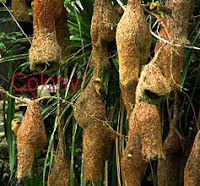 |
| Colony |
Ø Colony / ˈkɑːləni / (ˈকাঃলএনি) n [a group of animals, insects, or plants of the same type that live together or grow in the same place] (পাখি, কীট ইত্যাদির বসতি/ আবাস):
Ø Frond / frɑːnd / (ফ্রাঃন্ড্) n [a long leaf of some plants or trees, especially palms or ferns, Frond is often divided into parts along the edge] (< তাল গাছের>লম্বা পাতা): Ferns and palms have fronds.
 |
| Predator |
Ø Predator / ˈpredətər / (ˈপ্রেডএটএর) n [an animal that hunts, kills, and eats other animals] (শিকার জীবীপ্রাণী<যে প্রাণী আন্যপ্রানী শিকার করে তার মাংস খায়>): Some animals have no natural predators. Lion, wolves, and other predators
Ø Elaborate / ɪˈlæbərət / (ইˈল্যাবএরএট) adj [very complicated and detailed; carefully prepared and organized] (বিস্তারিত; সুনিপুন): She had prepared a very elaborate meal.
<ADJ> Elaborately (=বিস্তারিতভাবে; সুনিপুনভাবে): It was the most elaborately decorated cake.
Tailorbird
Tailorbird / ˈteɪlərbɜːrd / (ˈটেইলএরবা্র্ড) n [it is a brightly colored bird with bright green upperparts and whitish underparts. It has short, rounded wings, a long tail, strong legs, and a sharp bill with a curved tip to the upper mandible] ( টুনটুনি): Tailorbirds get their name from the way their nest is constructed. The edges of a large leaf are pierced and sewn together with plant fiber or spider silk to make a cradle in which the actual nest is built.
Ø Bill / bɪl / (বিল) n [the hard pointed or curved part of a bird’s mouth] (পাখির ঠোঁট):
<SYN> Beak
Ø Tip / tɪp / (টিপ) n [the thin, pointed end of Sth, especially something which is long and thin] ( আগা বা ডগা): The tips of your fingers.
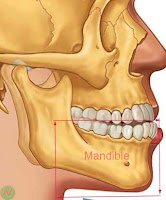 |
| Mandible |
Ø Mandible / ˈmændɪbl / (ˈম্যানডিবল্) n [in a person or animal, the lower jawbone] (<স্তন্যপায়ী প্রাণী এবং মাছের >নিম্নচোয়াল):
 |
| Pierce |
Ø Pierce / pɪrs / (পিয়ারছ্) v {Pt. Pp. pierced / pɪrst / (পিয়ারছ্ট্)} [to make a small hole in Sth, or to go through Sth, with a sharp object] (ছিদ্র করা; বিদ্ধ করা): The needle pierces the fabric four times a second.
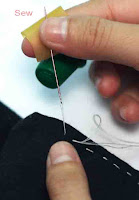 |
| Sew |
Ø Sew / soʊ / (ছৌ) v {Pt. sewed; Pp. sewn} [to join two pieces of cloth together by putting a thread through them with a needle] ( সীবন করা; সেলাই করা): My mother taught me how to sew.
Ø Silk / sɪlk / (ছিল্ক্) n [a delicate, soft type of cloth made from a thread produced by silk worms] (রেশমি সুতা; রেশম্): a silk shirt.
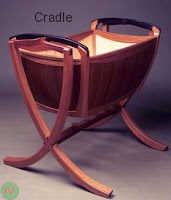 |
| Cradle |
Ø Cradle / ˈkreɪdl / (ˈক্রেইডল্) n [a small bed for a baby which can be pushed gently from side to side] (দোলনা): She rocked the baby to sleep in its cradle.
Mynah
Mynah / ˈmaɪnə / (ˈমাইনএ) n [a SE Asian bird with dark feathers, which can copy human speech] (ময়না):
Common Myna
Common Myna / ˈkɑːmən ˈmaɪnɒ / (ˈইন্ডিএন্ মাইনঅ) n [a bird is readily identified by the brown body, black hooded head and the bare yellow patch behind the eyes. The bill and legs are bright yellows. There is a white patch on the outer primaries and the wing lining on the underside is white] (শালিক): Indian Myna is often found resting on power lines.
Ø Readily / ˈredɪli / (ˈরেডিলি) adv [quickly and without difficulty] (নির্দ্ধিধায়; অনায়াসে; অবলিলাক্রমে): all ingredients are readily available from your local store.
Ø Hood / hʊd / (হুড) n [a piece of cloth, put over Sb’s head to cover the top and back of the head] (বোরখা; শিরোবস্ত্র; শিরোবেষ্টন; শিরষ্ক): The coat has a detachable hood.
A hooded Indian Myna (ঝুঁটিওয়ালা শালিক)
Bank Myna
Bank myna
/ bæŋk
ˈmaɪnɒ / (ব্যাঙ্ক ˈমাইনঅ) n [a
myna found in the northern parts of South Asia. It is smaller but similar in
coloration to the common myna, only differing in having brick-red naked skin
behind the eyes instead of yellow.] (গাঙশালিক):
Pied Myna
Pied Myna / paɪd ˈmaɪnɒ / (পাইড ˈমাইনঅ) n [it is striking marked in black and white and has a yellowish bill with a reddish bill base. The bare skin around the eye is reddish, the upper body, throat, and upper breast are black while the lower breast, belly, cheek, and rump are contrasting white] (গোশালিক): Pied Myna is often seen within cities, towns, and villages in small groups mainly on the plane lands and low foothills.
Ø Striking / ˈstraɪkɪŋ / (ˈস্ট্রাইকিং) adj [very unusual or easily noticed, and therefore attracting a lot of attention] (চিত্তহারী; বিস্মায়ক; চমকলাগানো): She was undoubtedly a very striking young woman.
<SYN> Stunning
Ø Rump / rʌmp / (রাম্প্) n [the round area of flesh at the top of the legs of an animal] (পশুর পশ্চাদ্ভাগ; পাখির পুচ্ছদেশ): She slapped in the rump.
Ø Contrasting / kənˈtræstɪŋ / (কএনˈট্র্যাছটিং) adj [very different in style, color, or attitude] ( তুলনামূলক; বিপরীত): bright contrasting colors. The book explores a contrasting view of the poet’s early work.
Ø Foothill / ˈfʊthɪl / (ˈফুটহিল) n [a low mountain or hill at the base of a higher mountain or range of hills] (পাহাড়ের পাদদেশে): the foothills of the Himalayas.
Sparrow
Sparrow / ˈspæroʊ / (ˈস্প্যারৌ) n [generally it is small, plump, brown-gray bird with short tails and stubby, powerful beaks] (চড়াইপাখি; চড়াই; চড়ুই): House sparrow preening
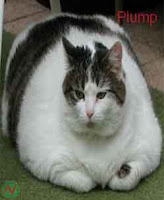 |
| Plump |
Ø Plump / plʌmp / (প্লাম্প) adj [having a soft, round body; slightly thick] (সুগোল; সুডৌল; ঢলঢল; হৃষ্টপুষ্ট): a baby with plump cheeks
Ø Stubby / ˈstʌi / (ˈস্টাবি) v [short and thick] (খাটো ও মোটা): stubby fingers
Ø Preen / priːn / (প্রীন্) v [<of a bird>to clean itself or make its feathers smooth with its stubby beak] (<পাখি সম্বন্ধে; ঠোঁট দিয়ে> পালক পরিপাটি করা):
Drongo
Drongo / ˈdrɑːŋgoʊ / (ˈড্রাংগৌ) n [a shiny black bird with a long forked tail] (ফিঙে):
Ø Forked / fɔːrkt / (ফোর্কট্) adj [with one end divided into two parts, like the shape of the letter ‘Y’] (শাখান্বিত; দুইশাখায় বিভাক্ত): a bird with a forked tail. The forked tongue of a snake
Kingfisher
Kingfisher / ˈkɪŋfɪʃər / (ˈকিংফিশএর) n [a small, brightly feathered bird with long, sharp, and pointed beaks, short legs, small, intensely shaded natural body, large heads, and stumpy extensions, they have extensively spiky bills help them in the consumption of the prey] ( মাছরাঙ্গা): The eggs of Kingfisher are white and glossy.
Ø Pointed / ˈpɔɪntɪd / (ˈপয়ন্টিড) adj [a pointed object has a thin, sharp end or becomes much narrower at one end] (চোখা; তীক্ষ্ণাগ্র): pointed teeth. The pointed arches are used in medieval buildings.
Ø Spiky / ˈspaɪki / (ˈস্পাইকি) adj [having sharp points] (সুচালো আগাযুক্ত): spiky leaves
Ø Glossy / ˈglɑːsi / (ˈগ্লা্ছি) adj [smooth and shiny] (মসৃণ ও উজ্জ্বল): She had wonderfully glossy hair.
Bulbul
Bulbul / ˈbʊlbʊl / (ˈবুলবুল) n [it is a short-necked slim bird. Its tails are long and wings short but rounded. Its bill is slightly elongated and a little bit hooded at the end. It has a melodious voice and drab plumage and has a pointed black crest] ( বুলবুল/ বুলবুলি): Bulbul bird love to live in woodland.
Ø Elongate / ɪˈlɔːŋgeɪt / (ইˈলোংগেইট) v [to become longer; to make Sth longer and often thinner] (দীর্ঘ করা; সম্প্রসারিত করা): The cells elongate as they take in water.
<SYN> Lengthen
<ADJ> Elongated / ɪˈlɔːŋgeɪtɪd / (ইˈলোংগেইটিড) adj [long and thin, often in a way that is not normal] (দীর্ঘায়িত; সম্প্রসারিত): In the photo, her face was slightly elongated.
<NOUN> Elongation / ˌiːlɔːŋˈgeɪʃn / (ˌঈলোংˈগেইশন্) n [ ? ] (সম্প্রসরণ; দীর্ঘকরণ): the elongation of vowel sounds
Ø Melodious / məˈloʊdiəs / (মএˈলৌডিএছ) adj [pleasant to listen to] (সুরেলা): a rice melodious voice
Ø Crest / krest / (ক্রেছট্) n [a large of feathers that stand up on top of a bird’s] (পাখির ঝুটি): The male is recognizable by its yellow crest.
Parrot
Parrot / ˈpærət / (ˈপ্যারএট্) n [a tropical bird with a curved, and strong beak, an upright stance, strong legs, and clawed feet. Many parrots are vividly colored, and some are multi-colored. Some parrots are kept as pets and can be trained to copy human voices] (তোতাপাখি): Almost all parrots nest in tree hollows, and lay white eggs.
 |
| Claw |
Ø Claw / klɔː / (ক্লো) n [one of the sharp curved nails at the end of each of the toes of some animals and birds] (পশুপাখির পায়ের তীক্ষ্ণ নখ): The cat lashed out with its claws.
Ø Vivid / ˈvɪvɪd / (ˈভিভিড) adj [<of light, colors, etc.> very bright] (তীব্র উজ্জ্বল): Vivid blue eyes
Ø Hollow / ˈhɑːloʊ / (ˈহা্লৌ) adj [having a hole or empty space inside] (ফাঁপা/ ফোকর): The tree trunk was hollow inside. His stomach felt hollow with fear.
Parakeet
Parakeet / ˈpærəkiːt / (ˈপ্যারএকীট্) n [a small bird of the parrot family, usually with a long tail] (টিয়া): Parakeet breed best in groups, but are usually fine breeding in pairs.
Lovebird
Lovebird / ˈlʌvbɜːrd / (ˈলাভ্বা্র্ড্) n [a small bird with brightly colored feathers African parrot with 13 to 17 centimeters in length and 40 to 60 grams in weight. They are a social and affectionate small parrot] (প্রেম পাখি; লাভ বার্ড):
Ø Affectionate / əˈfekʃənət / (এˈফেকশএনএট্) adj [showing feelings of liking or love] (স্নেহময়; স্নেহমাখা; মমতাময়): He is an affectionate little boy.
Verditer Flycatcher
Verditer flycatcher / ˈvɜːrdɪtər ˈflaɪkætʃər / (ভা্র্ডিটএর্ ফ্লাইক্যাচএর্) n [It is found from the
Himalayas through Southeast Asia to Sumatra. This species is named after its
distinctive shade of copper-sulphate blue and has a dark patch between the eyes
and above the bill base. The adult males are intense blue on all areas of the
body, except for the black eye patch and grey vent. Adult females and
sub-adults are lighter blues] (নীলাম্বরি):
Cuckoo
Cuckoo / ˈkɑːkətuː / (ˈকুকূ) n [a medium-sized long-tailed bird, typically with a gray or brown back and pale underparts, with a two-note call that sounds similar to its name, cuckoo leave their eggs in the nests of other birds] (কোকিল): The best place to spot a cuckoo is in woodlands, parks and open uplands.
Indian Cuckoo
Indian Cuckoo / ˈɪndiən ˈkʊkuː / (ˈইনডিএন
ˈকুকূ) n [the Indian cuckoo is a member of the cuckoo order of
birds; it is a medium-sized cuckoo. It has gray upper parts while the underside
has broad black barring. The tail is barred with a broad subterminal dark band
and a white tip] (বউ কথা কও): Indian cuckoo is a solitary
and shy bird found in forests and open woodland.
Ø Solitary / ˈsɑːləteri
/
(ˈছালএটেরি) adj
[done alone; without other people] (একাকী; নিঃসঙ্গ; নির্জন): He
enjoys long solitary walks. She led a solitary life.
<SYN> Single
Canary
Canary
/ kəˈneri / (কএˈনেরি) n [a small yellow bird that is well known for its
singing and is sometimes kept as a pet in a cage]
(হলদে
টুনি):
Ø Cage / keɪdʒ
/ (কেইজ্)
n [a space surrounded on all sides by bars or wire, in which animals or birds
are kept] (খাঁচা;
পিঞ্জর):
<VERB> Cage / keɪdʒ / (কেইজ্)
v cage [to put or keep an animal in a cage] (খাঁচায় রাখা; খাঁচাবদ্ধ করা): The dogs are
caged (up) at night.
Canary- Flycatcher
Canary- flycatcher / kəˈneri ˈflaɪkætʃər / (কএˈনেরি ফ্লাইক্যাচএর্) n [a small grey-headed bird have a fine-tipped bill which becomes broad and flat at the base] (ফুটফুটি):
Cockatoo
Cockatoo / ˈkɑːkətuː / (ˈকাকএটূ) n [an Australian bird of the parrot family is a cockatoo recognized by showy crests and curved bills. Their plumage is generally less colorful than that of other parrots, being mainly white, gray, or black, on average, they are larger than other parrots] (কাকাতুয়া): Cockatoos are popular birds in aviculture but their needs are difficult to cater for. Cockatoos prefer to eat seeds, tubers, corn, fruit, flowers, and insects.
Ø Showy / ˈʃoʊi / (ˈশৌঈ) adj [attracting a lot of attention by being very colorful or bright, but without any real beauty] (মনোমুগ্ধকর; নয়নাভিরাম): Her dress was too showy for such a formal occasion.
Ø Aviculture / ˈeɪvɪkʌltʃər / (ˈএইভিকালচএর) n [the practice of breeding and caring for birds] (পক্ষীপালন):
Ø <PHR-V> Cater for Sb/Sth / ˈkeɪtər fər / (ˈকেইটএর ফএর) v [to provide the things that a particular person or situation, needs or wants] (খাদ্যাদি সরবরাহ করা, আকাঙ্ক্ষিত বা প্রয়োজনীয় বস্তুর চাহিদা পূরণ করা): The class caters for all ability ranges.
Ø Tuber / ˈtuːbər / (ˈটুউবএর) n [the short, thick round part of an underground route of some plants, such as potatoes, which stores food and from new plants grow] (মাটির নিচের গাছের বর্দ্ধিত অংশ, যার অঙ্কুর থেকে নতুন চারা গজায়; কন্দ):
Jungle Babbler
Jungle Babbler / ˈdʒʌŋgl bæblər / (জা্ঙ্গল ব্যাবলএর) n [they are sociable birds that forage in small groups of six to ten birds, a habit that has given them the popular name of seven sisters or seven brothers] (সাতভাই ছাতারে; বনছাতারে): The jungle babbler has the harsh nasal call.
Ø Sociable / ˈsoʊʃəbl / (ˈছৌশএবল্) adj [describes someone who likes to meet and spend time with other fellows] (সঙ্গপ্রিয়; মিশুক; বন্ধুভাবাপন্ন; বন্ধুসুলভ): He was a sociable kid who will talk to anyone.
<SYN> Gregarious
Ø Forage / ˈfɔːrɪdʒ / (ˈফোরিজ্) v [<of animal>to go from place to place searching, especially for food] (<খাদ্য ইত্যাদি>খোজা বা অন্বেষণ করা): The females only leaves the young when she forages for food.
Ø Harsh / hɑːrʃ / (হাঃর্শ) adj [unpleasant to listen to] (রূঢ়; কর্কশ): a harsh voice
Stonechat
Stonechat / stoʊntʃæt / (স্টৌনচ্যাট) n [they are small flycatcher bird] (শিলাফিদ্দা):
Purple-rumped Sunbird
Purple-rumped Sunbird / ˈpɜːrpl-ˈrʌmt sʌnbɜːrd / (ˈপাঃর্পল-ˈরামট ছানবাঃর্ড) n [it is a Sunbird endemic to the Indian Subcontinent, like other. they are tiny at less than 10cm long with medium-length thin down-curved bills and brush-tipped tubular tongues, both adaptations for nectar feeding] (মৌটুসী): the Purple-rumped Sunbird is a common resident breeder in India, Sri Lanka, Bangladesh.
Ø Endemic / enˈdemɪk / (এনˈডেমিক্) adj [regularly found in a particular place or among a particular group of people and difficult to get rid of] (জাতিগত; দৈশিক বা আঞ্চলিক): corruption is endemic in the system.
Ø Tubular / ˈtuːbjələr / (ˈটুউব্যিএলএর) adj [made of tubes or of parts that are shaped like tubes]( নলাকার; চোঙ্গাকার): a tubular metal chair
Ø Adapt / əˈdæpt / (এˈড্যাপট্) v [to change Sth in order to make it suitable for a new use or situation] (খাপ খাওয়ানো; অভিয়োজিত করা): We have had to adapt quickly to the new system.
<SYN> Adjust
<NOUN> Adaptation / ˌædæp ˈteɪʃn / (ˌএ্যাড্যাপˈটেইশন্) n [the process of changing to suit different conditions] (খাপখওয়ানো; অভিযোজন): Evolution occurs as a result of adaptation to the new environment.
Ø Nectar / ˈnektər / (ˈনেকটএর) n [a sweet liquid that is produced by flowers and collected by bees for making honey and also other insects] ( পুষ্পরস; সুধা): The bee turns the nectar into honey.
White-rumped Shama
White-rumped Shama / waɪt -rʌmt ʃæmə / (ওআইট্-রামট্ শ্যামঅ) n [they typically weigh between 30 and 35g and are around 23-26 cm in length] (শ্যামা):
Small Pratincole
Small pratincole / smɔːl ˈprætɪnkoʊl / (স্মোল্ ˈপ্র্যাটিনকৌল্) n [the small pratincole, little pratincole, or small pratincole bird has short legs, long pointed wings, and a short tail. Its short bill is an adaptation to aerial feeding. The crown of the head is brown] (বাবুই বাটান):
Ø Aerial / ˈeriəl / (এরিএল্) adj {USA antenna} [in the air; existing above the ground] (বায়ুতে বিদ্যামান বা বায়ুর ভিতর দিয়ে চলমান; বায়ব্য): The banyan tree has aerial roots.
Munia
Munia / muːnɪə / (মূনিএ) n [the small bird Munia is about 10-12 centimeters long and weighs 14-16 grams. The adult has a stubby silver bill typical of grain-eating birds] (মুনিয়া):
Ø Stubby / ˈstʌbi / (ˈস্টাবি) adj [short and thick] (খাটো ও মোটা; হোঁতকা): The man had a large head and stubby little arms.
Green Bee-eater
Green bee-eater / griːn-biː ˈiːtər / (গ্রীন্ বী-ˈঈটার) n [it is a little bird in the Bee-eater family. It is a richly colored, slender bird; its entire plumage is bright green and tinged with blue, especially on the chin and throat. The crown and upper back are tinged with golden ruffs] (বাঁশপাতি): Green bee-eaters like to eat insects, especially bees, wasps, and ants, which are caught in the air by sorties from an open perch.
Ø Slender / ˈslendər / (ˈস্লেনডএর) adj [thin and delicate, often in a way that is attractive] (সরু; হালকা পাতলা): The plant’s leaves are long and slender.
Ø Tinge / tɪndʒ / (টিনজ্) v [to add a small amount of color to Sth] (<লাল ইত্যাদি রঙে> ঈষৎ রঞ্জিত করা): Pink tinged her pale cheeks.
Ø Crown / kraʊn / (ক্রাউন্) n [the top part of a head, hat or hill] (মাথার চাঁদি; কোনোকিছুর শেষ প্রান্ত): A pink ribbon had been tied around the crown of the hat.
Ø Ruff / rʌf / (রাফ্) n [a ring of colored or marked feathers or fur around the neck of a bird or an animal] (পশু বা পাখির গলায় ভিন্ন রঙের লোম বা পালকের বেষ্টনী; গলকণ্ঠী):
Ø Sortie / ˈsɔːrti / (ˈছোর্টি) n [a short, quick attack by a military force, such as a small group of soldiers or an aircraft] (আকস্মিক হামলা): They had made several sorties against enemy troops.
<SYN> Raid
Owl
Owl / aʊl / (আউল্) n [a bird with a flat face, large round eyes, and strong, curved nails, that hunts small mammals at night] (পেঁচা): An Owl hooted nearby.
Ø Mammal / ˈmæml / (ˈম্যাম্ল্) n [any animals which gives birth to live babies, not eggs, and feeds its young on milk] (স্তন্য পায়ী প্রাণী):
Ø Hoot / huːt / (হূট) v [to make the sound that an owl makes] (পেঁচার ডাক): The cry of an Owl[hoot]
Shrike
Shrike / ʃraɪk / (শ্রাইক্) n [a bird with a strong beak that catches small birds and insects and sticks them on thorns] (কসাই পাখি):
Ø Stick / stɪk / (স্টিক্) v {Pt. Pp. stuck / stʌk / (স্টাক্)} [to push Sth, usually a sharp object, into Sth] (বিদ্ধ করা; গেঁথে দেওয়া): A thorn stuck in her finger.
Bay-backed Shrike
Bay-backed shrike / beɪ-bækt ʃraɪk / (বেই-ব্যাক্ট শ্রাইক্) n [it is smallish shrike at 16 cm, maroon-brown above with a pale rump and long black tail with white edges. There is a small white wing patch and the bill and legs are dark greys] (তামাপিঠ লাটোরা):
Eagle
Eagle / ˈiːgl / (ˈঈগল্) n [eagle are large, powerful built-in birds of prey, with heavy heads and beaks. They have large hooked beaks for tearing flesh from their prey, strong muscular legs, and powerful talons. Its eyes are extremely powerful, having up to 3.6 times human acuity. That enables them to spot potential prey from a very long distance] (ঈগল):
Ø <PHY> Eagle eye [=if someone has an eagle eye, they watch everything carefully and even very small details] (প্রক্ষর/ তীক্ষ্ণ দৃষ্টি সম্পন্ন): Nothing escaped our teacher’s eye. My eagle-eyed mother noticed that some cakes had gone missing.
Ø Built-in / bɪlt -ɪn / (বিল্ট-ইন) adj [included as part of Sth and not separate from it] (সন্নিবিষ্ট): Our built-in weaknesses
Ø Hooded / hʊkt / (হুকট্) adj [curved, shaped like a hook] (বড়শি আকৃতি; বক্র): A hooked beak
Ø Tear / ter / (টেয়ার) v {Pt. tore; Pp. torn} [to remove Sth from the else by pulling it roughly or violently] (ছেঁড়া; ছিঁড়ে ফেলা; ছিন্ন করা): She tore another sheet from a pad.
<SYN> Rip
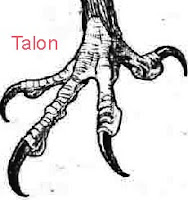 |
| Talon |
Ø Talon / ˈtælən / (ˈট্যালএন) n [a long sharp curved nail on the feet of some birds, which use when hunting prey] (বাঁকানো নখর):
Ø Acuity / əˈkjuːəti / (এˈকিউএটি) n [the ability to hear, see or think accurately and clearly] (তীক্ষ্ণতা): Tiredness also affects visual acuity.
Ø Potential / pəˈtenʃl / (পএˈটেনশল) adj [that can develop into Sth or be developed in the future] (সম্ভাব্য): Potential customers
<SYN> Possible
1. Kite
Kite / kaɪt / (কাইট) n 1. [a bird of prey of the hawk family that kills and eats small animals] (চিল):
 |
| 2. Kite |
Ø Kite / kaɪt / (কাইট) n 2. [one kind of toy made of a light frame covered with plastic, paper, or cloth that is flown in the air at the end of one long string, especially for pleasure] (ঘুড়ি): Kites were invented in China.
Falcon
Falcon / ˈfælkən / (ˈফ্যালকএন) n [a bird with pointed wings and a long tail that can be trained to hunt other small birds and small animals, and they also kill other creatures for food] (বাজপাখি):
Hawk
Hawk /
hɔːk / (হোঃক্) n [a type of
large, strong, fast bird of prey that catches small birds and animals for food] (শ্যেন পাখি): The hawk swooped low
over the field.
Sparrow Hawk
Sparrow hawk / ˈspæroʊ hɔːk / (ˈস্প্যারৌ
হোঃক্) n [a
small bird of prey refers to several species of small hawk in the genus
Accipiter.] (চড়ুইশ্যেন পাখি):
Vulture
Vulture /
ˈvʌltʃər / (ˈভালচএর) n [a large bird, usually without feathers on its head or
neck that eats the flesh of animals that are already dead] (শকুন): Vultures are classified into two groups, Old
World vulture and New World vulture. Vultures rarely attack healthy animals but may kill the wounded or sick ones.
Woodpecker
Woodpecker / ˈwʊdpekər / (ˈউড্পেকএর) n [a bird with a long, strong beak to make holes in tree trunks when it is looking for insects to eat] (কাঠঠোকরা): The woodpecker’s range of highly antisocial solitary species that is aggressive toward other species, to species that live in groups.
 |
| Trunk |
Ø Trunk / trʌŋk / (ট্রাংক) n 1. [The thick main stem of a tree that the branches grow from] (<গাছের> গুড়ি; কাণ্ড)
Ø Solitary / ˈsɑːləteri / (ˈছালএটেরি) adj [done alone; without other people] (একাকী; নিঃসঙ্গ; নির্জন): He enjoys long solitary walks. She led a solitary life.
<SYN> Single
Nightingale
Nightingale / ˈnaɪtɪŋgeɪl / (ˈনাইট ইগেইল) n [a small brown bird known especially for the nice song of the male, which is usually heard during the night, it has plain brown above except for the reddish tail. It is a buff to white below] (পাপিয়া; ক্ষুদ্র লালচে বাদামী রঙের যাযাবর গায়ক পাখি বিশেষ): The song of the nightingale has been described as one of the most beautiful sounds in nature.
Ø Buff / bʌf / (বাফ্) adj [pale yellow-brown in color] (হালকা হলুদ-বাদামী বর্ণ):
<SYN> Beige
Hummingbird
Hummingbird / ˈhʌmɪŋbɜːrd / (ˈহামিং বাঃর্ড) n [a very small, brightly colored bird with a long thin beak, that lives in warm countries and that can stay in one place in the air by beating its wings very fast, making a continuous low sound] (গুঞ্জন পাখি):
Mockingbird
Mockingbird
/ ˈmɑːkɪŋbɜːrd / (ˈমাঃকিঙ্বা্র্ড্) n [a grey and
white American or Australian birds that can copy the sounds made by other birds] (হরবোলা পাখি <যে পাখি
আন্য পাখির সুর নকল করতে পারে>):
Swallow
Swallow / ˈswɑːloʊ / (ˈসোআলৌ) n [a tiny bird with long pointed wings and a tail with two points, that spends the winter in Africa, but flies to northern countries for the summer, which flies quickly and catches insects to eat as it flies] (আবাবিল): Swallows are insectivorous, taking flying insects on the wing.
Ø Insectivore / ɪnˈsektɪvɔːr / (ইনˈছেকটিভোর) n [any animal that eats the insect] (কীটভূকপ্রাণী; কীটাশী)
<ADJ> Insectivorous
Skylark
Skylark / ˈskaɪ lɑːrk / (ˈস্কাইলার্ক) n [a small bird is about 15 to 17 centimeters long. It is a bird of open farmland and heath, that sings while it flies high up in the sky] (ভরতপাখি):
Ø Heath / hiːθ / (হীথ্) adj [a large area of open land that is not used for farming and is covered with rough grass and other small wild plants] (পতিত জমি; জঙ্গলা)
Toucan
Toucan / ˈtuːkæn /
(ˈটূক্যান্) n [a South
American fruit-eating bird with some areas of very brightly colored plumage,
and that has a massive colored beak] (দীর্ঘচঁচু পাখি):
Hornbill
Hornbill / ˈhɔːrnbɪl / (ˈহোর্নবিল্) n [a tropical bird with a very large curved beak] (ধনেশ <পাখি>):
Peacock
Peacock / ˈpiːkɑːk / (ˈপীকাঃক্) n [a large bird, the male of which has very long tail feather which it can spread out to show bright colors and patterns shaped like eyes] (ময়ূর):
Oriole
Oriole / ˈɔːrioʊl / (ˈওরিওউল্) n [a North American bird that has
black and yellow or orange feathers] (ওরিঔল বা বেনেপাখি):
Black Hooded Oriole
Black-hooded oriole / blæk ˈhʊdɪd ˈɔːrioʊl / (ব্যাক ˈহউডিড ˈওরিঔল) n [it is a member of the oriole family and is a resident breeder in tropical southern Asia.] (বেনেবউ; হলদে পাখি): The black hooded oriole lives in common contact with humans in rural and urban areas.
Barbet
Barbet /
ˈbɑːrbɪt /
(বাঃর্বিট্) n [any small tropical brightly colored
bird of the family Capitonidae, having short weak wings and a sharp stout bill
with a tuft like feathers at its base] (বসন্তবৌড়ী):
Blue-throated Barbet
Blue-throated Barbet / bluː θroʊtɪd bɑːrbet / (ব্লূ থ্রৌটিড বাঃর্বেট) n [it is an Asian Barbet having bright green, blue and red plumage, seen across the Indian subcontinent and Southwest Asia.] (নীল গলা বসন্তবৌড়ী):
Pheasant
Pheasant
/ ˈfeznt /
(ˈফেজন্ট্)
n [a large bird with a rounded body and long
tail, the male of which is brightly colored, and is often shot for sport and
then eaten, meat from this bird is also called pheasant]
(ফেজনট্):
Starling
Starling
/ ˈstɑːrlɪŋ
/ (ˈস্টআঃরলিং)
n [very common bird with greenish-black feathers
covered in pale spots, often fly around in large groups, and has a noisy call] (স্টারলিং):
Hoopoe
Hoopoe / ˈhuːpoʊ /
(ˈহূপৌ) n [an orange-pink bird found in Africa, Asia, and
Europe, with a beak that curves downwards, a large crest on its head, and black
and white wings and tail] (হূপৌ):
Bustard
Bustard /
ˈbʌstərd
/ (ˈবাস্টএর্ড্) n [a large,
heavy bird that can run fast across the ground, they have long strong legs, heavy
body, a long neck, and speckled plumage] (বাস্টার্ড্):
Fantail
Fantail /
ˈfænˌteɪl
/ (ˈফ্যান্ˌটেইল্) n [a small-bodied bird with long tails; in some species
the tail is longer than the body and in most the tail is longer than the wing.
When the tail is folded it is rounded at the end, but when spread in the display or
aerial foraging, that can be opened like a fan] (পাখাপুচ্ছ
পাখি):
Tit
Tit / tɪt / (টিট্) n [a common small bird found in the northern half of the
world, that eats insects and seeds. There are several kinds of tit.] (চুচুক পাখি):
Dove
Dove / dʌv / (ডাভ্) n [a bird of the pigeon family, a white or gray dove,
the white one is often used as a symbol of peace]
(ঘুঘু): A dove cooed softly. She wore a dove-gray suit.
Ø Coo / kuː
/
(কূ)
v [when a dove or a pigeon coos, it makes a soft low sound] (ঘুঘুর ডাক):
Pigeon
Pigeon /
ˈpɪdʒən /
(ˈপিজএন্) n [a fat grey
and white bird with short legs, which is often seen in sitting on buildings in
large groups, and sometimes eaten as food] (কবুতর):
House Crow
House crow
/ haʊs kroʊ
/ (হাউজ্ ক্রৌ) n [also known as the Indian, grey necked, Ceylon, or
Colombo crow, is a common bird of the crow family that is of Asian origin but
now found in many parts of the world, where they arrived assisted by shipping.] (পাতিকাক বা পাতিকাউয়া):
Crow
Crow / kroʊ / (ক্রৌ) n [a large
bird, completely or mostly black, with a loud, harsh noise] (কাক):
Raven
Raven / ˈreɪvən /
(ˈরেইভএন্) n [the largest bird in the crow family, with shiny black
feathers and a deep harsh call] (দাঁড় কাক;
বায়স):

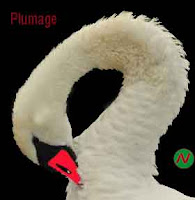
























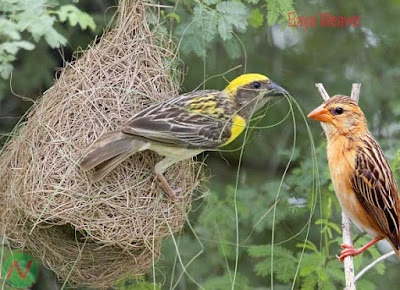












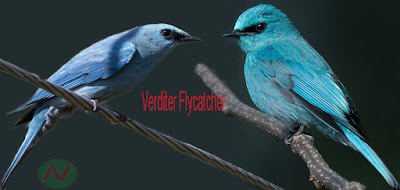

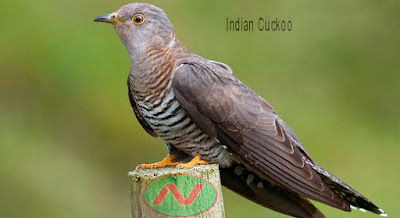

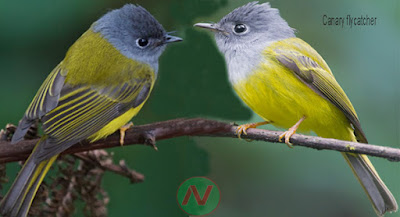




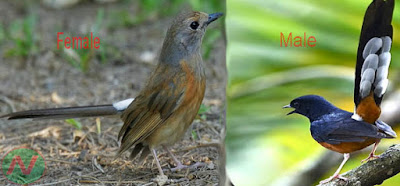

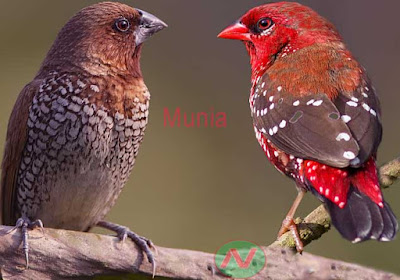



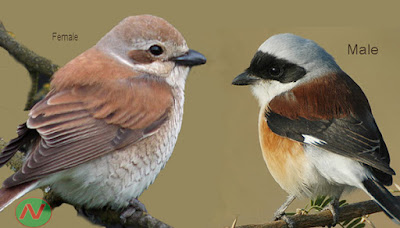








































No comments